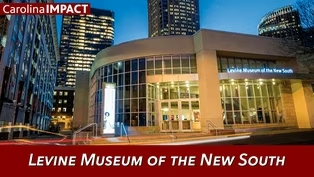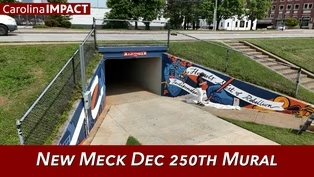
Church Camp Revival | Carolina Impact
Clip: Season 13 Episode 1306 | 6m 22sVideo has Closed Captions
Two historic NC camp meetings keep faith, family, and fellowship alive for generations.
They look like towns from the Old West, weathered cabins circling an old wooden arbor. But Rock Springs and Tucker’s Grove aren’t relics. They’re living traditions where faith, history, and community meet. Each summer, families return to pray, sing, eat, and keep Carolina’s camp meeting spirit alive.
Problems playing video? | Closed Captioning Feedback
Problems playing video? | Closed Captioning Feedback
Carolina Impact is a local public television program presented by PBS Charlotte

Church Camp Revival | Carolina Impact
Clip: Season 13 Episode 1306 | 6m 22sVideo has Closed Captions
They look like towns from the Old West, weathered cabins circling an old wooden arbor. But Rock Springs and Tucker’s Grove aren’t relics. They’re living traditions where faith, history, and community meet. Each summer, families return to pray, sing, eat, and keep Carolina’s camp meeting spirit alive.
Problems playing video? | Closed Captioning Feedback
How to Watch Carolina Impact
Carolina Impact is available to stream on pbs.org and the free PBS App, available on iPhone, Apple TV, Android TV, Android smartphones, Amazon Fire TV, Amazon Fire Tablet, Roku, Samsung Smart TV, and Vizio.

Introducing PBS Charlotte Passport
Now you can stream more of your favorite PBS shows including Masterpiece, NOVA, Nature, Great British Baking Show and many more — online and in the PBS Video app.Providing Support for PBS.org
Learn Moreabout PBS online sponsorshipWell finally tonight, tucked away in our region are traditions that have stood the test of time.
The church camp meetings are one of them.
At Rock Springs and Tucker's Grove, they're not just about preaching and prayer.
They're about family tents that feel more like time machines, memories that echo through generations and plenty of laughs.
"Carolina Impact's" Chris Clark shows us why people keep coming back, year after year, rain or shine.
(screen whooshing) - [Chris] They look like a town straight outta the Old West.
Weathered wood, dirt paths, rows of tiny cabins.
- I always have to pull out my phone and show pictures 'cause I said, "I can't really explain it.
You won't believe it."
- [Chris] And he's right.
Some people thought it was a movie set.
- Movies have been made from the campground.
- [Chris] This isn't Hollywood, something much older.
Long before phones, cars, or even electric lights, families in North Carolina were gathering under the arbors.
They came to pray, to sing, and to be together.
Two camps, Rock Springs and Tucker's Grove.
They tell the story of faith that has lasted generations.
- It was circuit riders would come in, people would bring their wagons and stuff and their chickens and their cows, and everybody would camp out here and they'd have revival all week.
- [Chris] Rock Springs held its first camp meeting in 1794.
And by 1830, the first permanent wooden tents were built.
And it's believed to be the oldest continuous camp meeting in the United States.
Gatherings always come in August, the one time farm families could step away.
- This was the time of year that the farmers had laid their crops by.
They'd already harvested, so they was in between the harvesting and planting again.
So this was the only time that they actually could take a vacation.
- [Chris] Nearly a century later, in 1874, African American families built Tucker's Grove Camp.
Born in the years after emancipation, it became a sacred space where newly freed men and women could worship freely and build a community.
It was also about more than faith.
It was about independence.
- That freedom gave them opportunity to use their own minds, their own ability, their own organizational, managerial skills and structure.
- [Chris] Both campgrounds have a similar layout.
Rows of tents form a great square surrounding a center point.
At the very heart stands the arbor, a wooden shelter where generations have gathered to hear the word.
Its construction as remarkable as it is humble.
- They built an arbor like a shelter that was made out of trees.
And from what I understand, there's no nails in the making of the arbor.
There's only some wood pegs.
- [Chris] The arbor at Rock Springs was started in 1830, and finished in 1832.
Nearly two centuries later, it's the only original structure left.
Its survival came against some incredible odds.
- The Union Army camped here on their way to Salisbury.
And when they left, they burned the structures down.
Everything burned except for tent number one and the arbor area.
- [Chris] From the ashes, the camp was rebuilt.
The arbor remained at the center, a symbol of survival.
Around it, new wooden tents sprang up, two stories tall, built with rough hewn boards, concrete floors, and a small kitchen.
Simple, but surprisingly comfortable.
And in today's world, nearly impossible to come by unless you stumble across one at the right moment.
- We actually were sitting in the Tractor Supply parking lot of Denver.
It came up online that this tent was available.
My husband was inside shopping.
I went inside, grabbed him, left his cart of goods inside, and met the lady here and bought tent number one.
- [Chris] Tent number one is the crown jewel, but every tent holds its own memories.
For generations, they'd been the backdrop for worship, friendships and family stories that last a lifetime.
From the bugle call that signaled time for church.
- Mr.
Euless Whitener was his name.
And he would stand out there.
And when you heard that bugle blow, and all the kids knew either you had to go into your tents, or you had to go under the arbor.
- [Chris] To the late night laughter through cracks in the walls.
- Everybody didn't have a curfew.
We always had to have a curfew.
And my mama had nine children.
And we always had to go to bed.
And you see these cracks here?
We talked to people through the crack because we were the early birds!
- [Chris] And those same walls and gaps weren't just for whispers.
They became the playground for childhood adventures.
- People had walkways between.
Back in the day, we'd get in between them when they'd be sitting there as kids and we'd put their feet up against 'em and climb up high above everybody and have water balloons and drop water balloons on people.
- [Chris] Not every memory was fun.
Some were just plain chores.
- I hated that iceman.
I just didn't like to sat out there.
I felt like everybody was looking at me, when mama made me sit out there and wait on that darn ice man.
- [Chris] As those kids got older, the fun didn't stop.
Camp meeting wasn't only about sermons, it was also about music, laughter, and finding a place to let loose.
- It used to be a little dance place.
And it was right down there.
It's a little guy.
His name was Mr.
Red Smith.
We called him Mr.
Red Smith, but he had a jukebox in a building.
And honey, when church was out, it was time to kick up the dust!
- [Chris] The campgrounds became a backdrop for friendships, first dances, and even young love.
- When I was dating my husband, we came out to the campground and we would walk around.
We had pictures made.
- [Chris] Those early walks turned into lifetimes.
Couples who met here returned with children of their own.
And now, with grandchildren.
- We had two of our grandchildren up here.
The first week, the oldest grandson said, "Dad, we have to go home tomorrow."
- You don't see kids running around with iPads.
You don't see kids running around with cell phones.
- [Chris] Camp meeting is a time to put life on pause, to come together face to face with neighbors, with family, and with Jesus at the center of it all.
- This is their heritage.
This is where their family came, and they know that they can come back here.
And this is a big reunion for them to come back here and worship and to sit in the same pews, the same place that everybody their ancestors did.
- [Chris] From Rock Springs to Tucker's Grove, camp meetings are more than cabins and arbors.
They're living testaments of faith, family, and fellowship, where generations return year after year, keep the story alive.
For "Carolina Impact," I'm Chris Clark.
Classroom Training Takes Flight | Carolina Impact
Video has Closed Captions
Clip: S13 Ep1306 | 5m 29s | Charlotte students take their aviation skills to an industry where they’re in high demand. (5m 29s)
Levine Museum of the New South | Carolina Impact
Video has Closed Captions
Clip: S13 Ep1306 | 6m 5s | The Levine Museum of the New South faces a unique situation: being temporarily homeless. (6m 5s)
Mecklenburg Declaration of Independence Mural | Carolina Impact
Video has Closed Captions
Clip: S13 Ep1306 | 4m 35s | The Mecklenburg Declaration of Independence is honored with new mural in Independence Park. (4m 35s)
October 14, 2025 Preview | Carolina Impact
Preview: S13 Ep1306 | 30s | Classroom Takes Flight; Levine Museum of the New South; New Mecklenburg 250th Mural; & Church Camp (30s)
Providing Support for PBS.org
Learn Moreabout PBS online sponsorship
- News and Public Affairs

Top journalists deliver compelling original analysis of the hour's headlines.

- News and Public Affairs

FRONTLINE is investigative journalism that questions, explains and changes our world.












Support for PBS provided by:
Carolina Impact is a local public television program presented by PBS Charlotte



